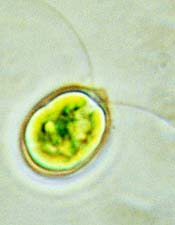
 |
Freethought & Rationalism ArchiveThe archives are read only. |
|
|
#111 | |
|
Senior Member
Join Date: Feb 2003
Location: Wales, UK
Posts: 931
|
This is a wonderful thread! I have to get me an encyclopedia of mammals (with pictures, obviously
 ) )Quote:
Thanks, TW |
|
|
|
|
|
#112 | |
|
Senior Member
Join Date: Jan 2002
Location: California
Posts: 646
|
Quote:
|
|
|
|
|
|
#113 | |
|
Veteran Member
Join Date: Aug 2001
Location: Singapore
Posts: 2,875
|
Today's whatsits are the lancelet, Amphioxus lanceolatus and Pikaia gracilens.
Simple question: Is it a vertebrate, or an invertebrate? Surely creationists know their metakinds right?  It has a notochord--a stiff tissue that supports the dorsal nerve cord, pharyngeal gill slits, and myomeres--flanks of muscles arranged in a zigzag or V-shape (known as chevrons) in its body. These are all vertebrate features. On the other hand, it lacks vertebrae (or for that matter, any real skeletal or cartilaginous mass), and has an extremely primitive brain (with no cranium)--more like a swollen bit at the end of its nerve cord. See here: A similar creature, Pikaia gracilens, turns up in the Burgess Shale, sharing many features including the notochord and chevrons; and lacking the similar features that exist in vertebrates.  Simon Conway Morris, in one of his rare lucid moments in an otherwise very-hard-to-read book, writes: Quote:
See how the lancelet is shedding light on vertebrate origins, in particular, this humble little creature may shed light on how our brains originally evolved: In Search of Vertebrate Origins: Beyond Brains and Bone |
|
|
|
|
|
#114 |
|
Veteran Member
Join Date: Nov 2001
Location: NCSU
Posts: 5,853
|
IIRC, an amok is a Southeast Asian mythological creature similar to Bigfoot.
|
|
|
|
|
#115 | |
|
Veteran Member
Join Date: Sep 2002
Location: Minnesota
Posts: 4,215
|
Quote:
Just wanted to let all you knowledgeable posters know these pictures are great! Reminds me a bit of a series of books my family had when I was a kid: "The Life of a Pond," "The Life of an Ocean," Prairie, Forest, etc. Guess my parents, despite their deep faith, still wanted kids who knew something. (Hmmm, I don't recall if any of my other siblings spent as much time perusing these books as I did. I'm the only out-and-out non-believer. Were seeds of enlightenment being planted unknowingly?) Also welcome to Minnesota, from another Minnesotan. Enjoying your input to the discussion. |
|
|
|
|
|
#116 |
|
Senior Member
Join Date: Nov 2001
Location: Ecuador
Posts: 738
|
Just for fun, and to add a bit to Minnesota's post, here's another interesting bit of "stump the cretinist":
 Black headed-vulture Coragyps atratus, family Cathartidae, order Falconiformes (Hey Coragyps, is this where you get your name?)  Caracara Caracara plancus, family Falconidae, order Ciconiiformes Egyptian vulture Neophron percnopterus, family Accipteridae, order Falconiformes  Palm-nut vulture Gypohierax angolensis, family Accipiteridae, order Falconiformes edited to add: PS: The palm nut vulture is in dispute. Scientists are still arguing whether it represents an eagle-like vulture, or a vulture-like eagle. It actively hunts, scavenges, and as its name implies, eats palm nuts! |
|
|
|
|
#117 |
|
Senior Member
Join Date: Mar 2002
Location: San Narcisco, RRR
Posts: 527
|
<snip pictures of vultures>
Anybody have a picture of the Eye-Chewing Vulture, frequently found on Talk.Origins? KC |
|
|
|
|
#118 |
|
Contributor
Join Date: Jul 2000
Location: Lebanon, OR, USA
Posts: 16,829
|
The one-celled green alga Chlamydomonas reinhardtii: plant or animal?
 It photosynthesizes, and it can move itself; what's sticking out of it are its flagella. This is a common feature among one-celled "algae"; I'm using Chlamydomonas as a convenient example. And yes, its genome is now being sequenced. |
|
|
|
|
#119 |
|
Regular Member
Join Date: Mar 2003
Location: Minnesota
Posts: 172
|
Chlamydomonas reinhardtii is a member of the plant kingdom (NCBI taxonomic classification).
|
|
|
|
|
#120 | |
|
Veteran Member
Join Date: Oct 2001
Location: Eastern U.S.
Posts: 1,230
|
Quote:
Cheers, Michael |
|
|
|
| Thread Tools | Search this Thread |
|